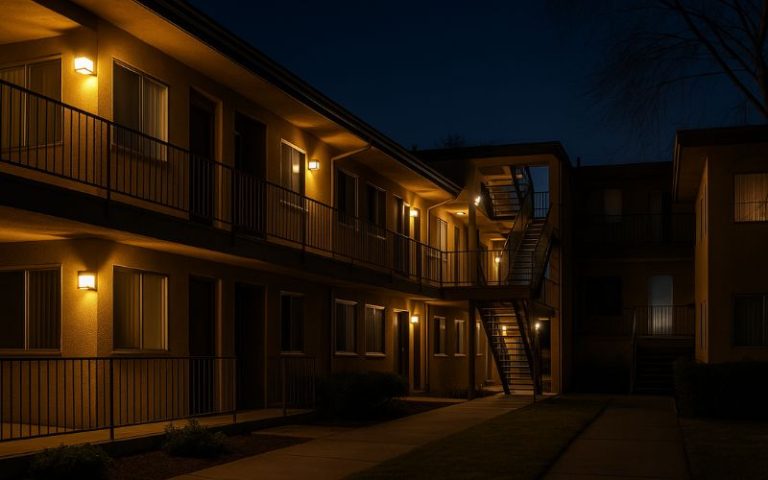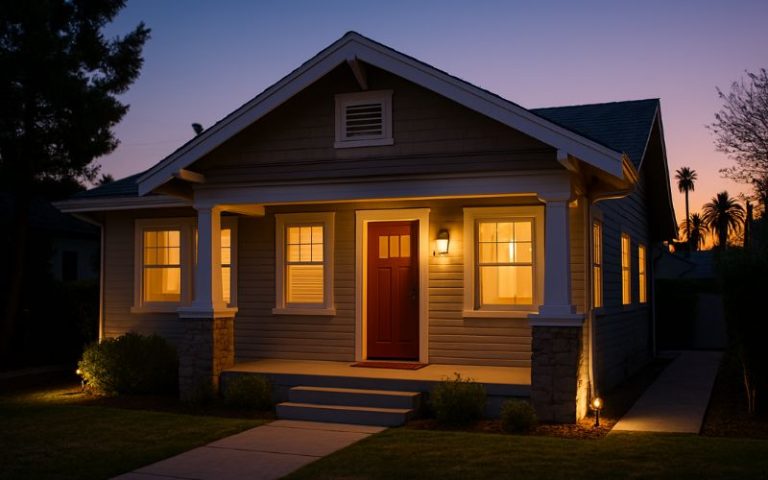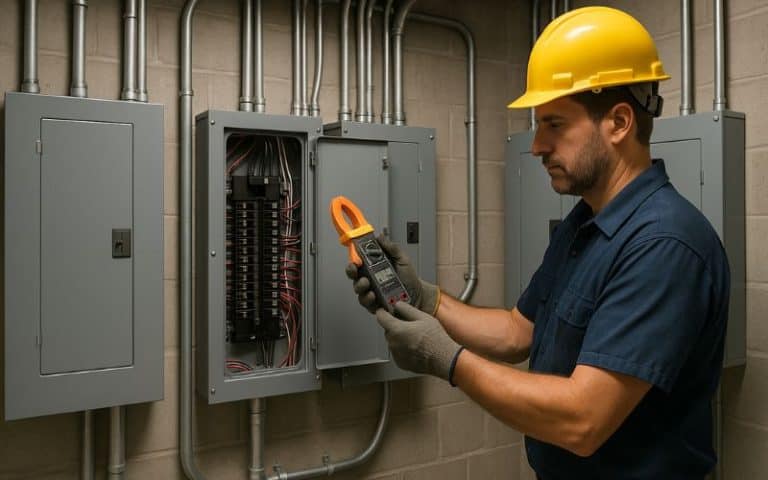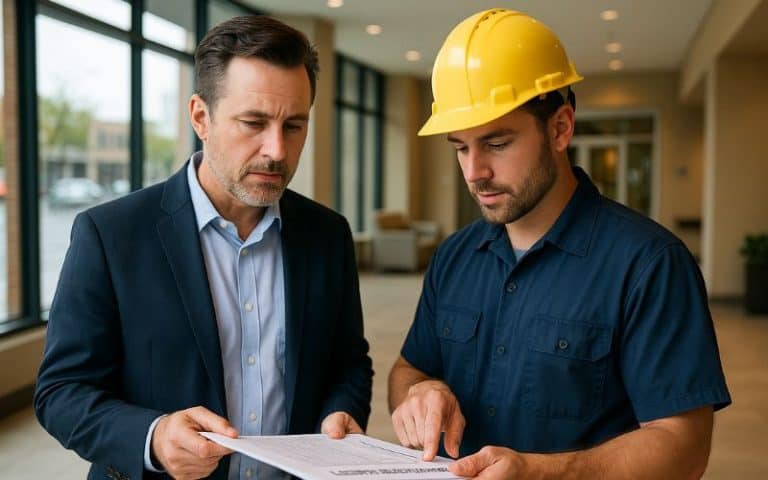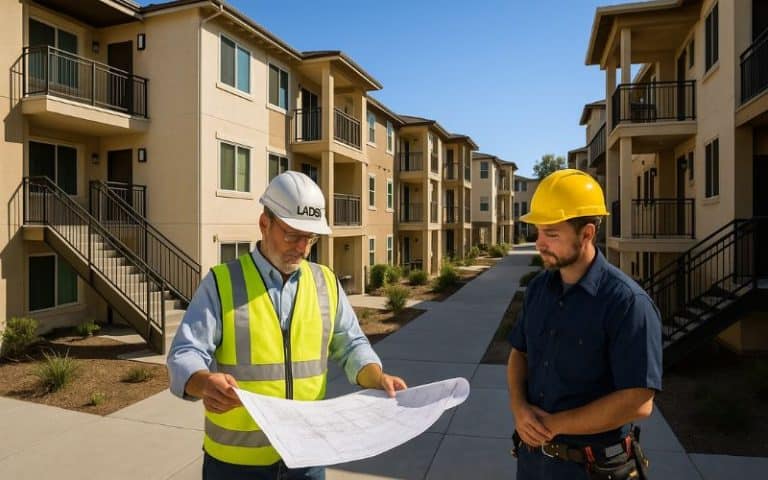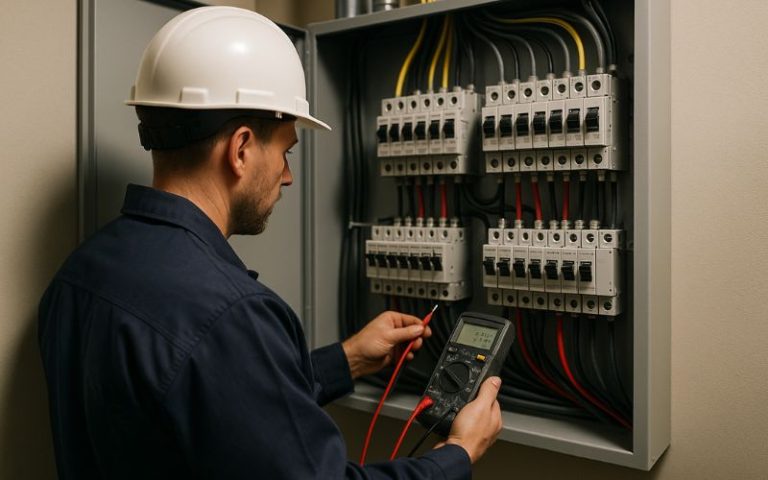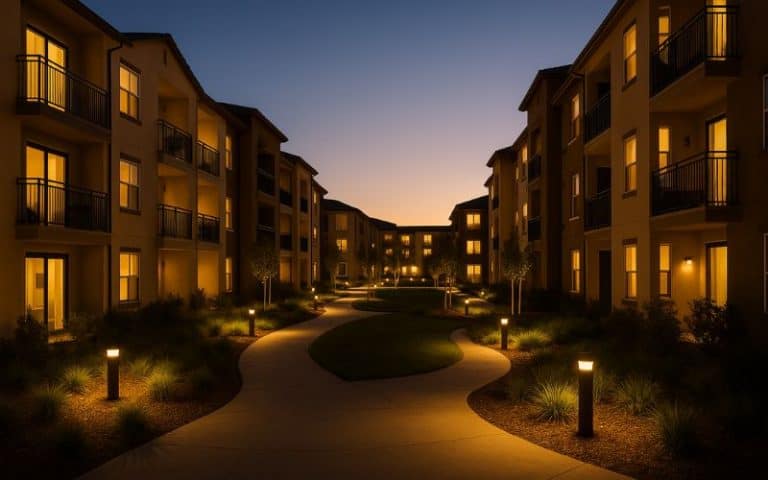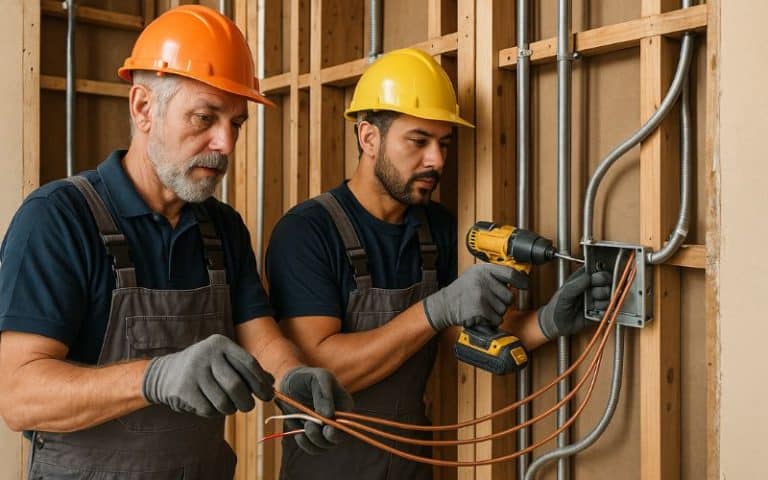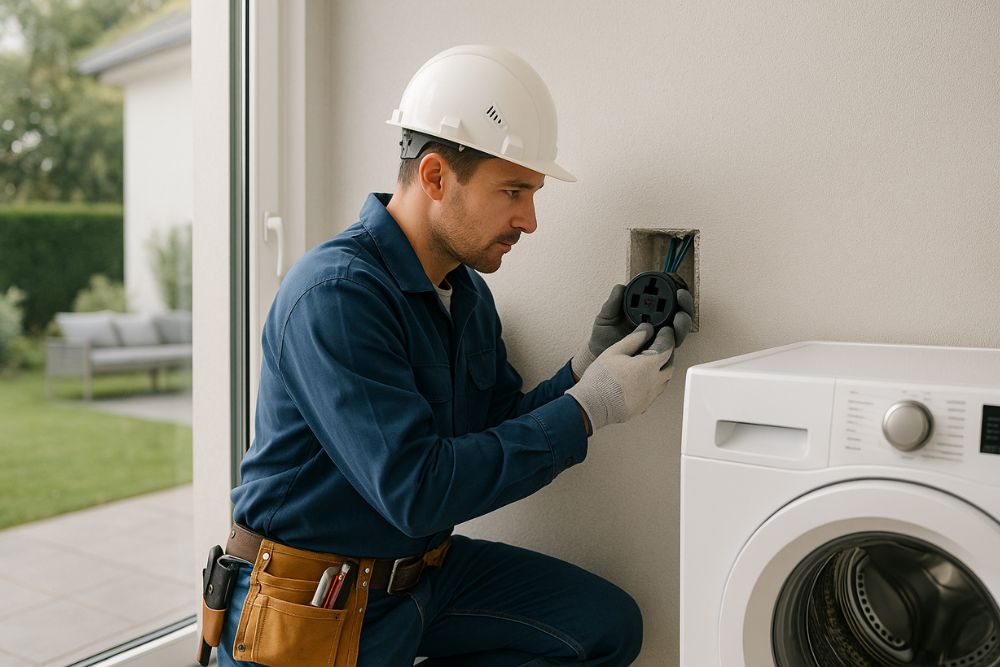
Is 220V More Efficient Than 110V? What Los Angeles Homeowners Should Know
110V vs 220V: What’s the Difference?
Most Los Angeles homeowners are familiar with the standard outlets around their home — the ones that accept two or three prongs and provide “110 volts” of electricity. But if you’ve ever looked behind your dryer or oven, you’ve probably noticed a much larger, different-looking outlet. That one supplies “220 volts.” At first glance, it may seem confusing. Why do homes in the U.S. use two different voltages, and what does it mean for safety, efficiency, and your electric bill?
A Short History of Voltage in the U.S.
In the early days of electricity, American utility companies adopted a lower-voltage standard (around 110 volts) because it was safer for the wiring available at the time and posed less risk of severe shock. Over time, as appliances grew more powerful, the need for higher-voltage circuits became obvious. Instead of switching the entire country to 220 volts (as many other nations did), U.S. electricians developed a dual system. Today, most household outlets supply 110V, while specific high-demand appliances — dryers, ovens, and EV chargers — use 220V.
So in a typical Los Angeles home, you have both: 110V powering lamps, TVs, and computers, and 220V dedicated to heavy-duty appliances.
The Basics: Voltage, Amperage, and Wattage
To understand the difference between 110V and 220V, it helps to look at how electricity is measured. Think of voltage as the pressure pushing electricity through wires, amperage as the volume of electricity flowing, and wattage as the total power used.
Here’s the key:
- 110V outlets deliver electricity at a lower pressure, which means more current (amperage) is needed to power high-demand appliances.
- 220V outlets deliver electricity at a higher pressure, which means they can power the same appliances using less current.
In simple terms, 220V is more efficient at moving power-hungry devices because it doesn’t require as much amperage. That’s why it’s used for clothes dryers, stoves, and EV chargers.
What You’ll Find in Los Angeles Homes
Los Angeles homes — especially older ones — often have a limited number of 220V circuits. In fact, some properties built before the 1970s may have only one or two 220V outlets, dedicated to the laundry or kitchen. But modern lifestyles demand more. With electric vehicles, central air conditioning, and high-capacity appliances, many homeowners discover they don’t have enough 220V supply.
During electrical inspections, we often find homeowners running extension cords, overloading 110V circuits, or even attempting dangerous DIY “conversions.” These workarounds may seem like a quick fix, but they create fire hazards and can void insurance coverage. A professional electrician can install additional 220V outlets or upgrade your panel to ensure your home is safe and ready for modern electrical loads.
👉 Related: Electrical Panel Services in Los Angeles
Why the Difference Matters
At the end of the day, the difference between 110V and 220V isn’t just technical jargon — it’s about how your home handles power. If you’ve ever wondered why your phone charger works in a small outlet but your oven needs a giant plug, it all comes down to voltage. Understanding this distinction helps homeowners make better decisions about upgrades, remodels, and appliance purchases.
In the next section, we’ll dig deeper into the big question: is 220V actually more efficient than 110V, and can it save you money on your electric bill?
The Science of Voltage and Efficiency
When Los Angeles homeowners ask whether 220V is more “efficient” than 110V, the answer is both simple and nuanced. The short version is: the cost of running an appliance depends on wattage — not the voltage alone. But because 220V circuits use less current (amperage) to deliver the same amount of power, there are situations where it can be more practical, safer, and yes, sometimes more efficient. Let’s break it down.
Power = Voltage × Current
All electrical power boils down to a simple formula: Watts = Volts × Amps. If you have a 1,000-watt appliance, you can deliver that power in two different ways:
- At 110 volts, it will draw about 9 amps.
- At 220 volts, it will draw about 4.5 amps.
The total wattage — and therefore the total electricity consumed — is the same. Your utility bill doesn’t change just because the appliance runs on a different voltage. That’s why you don’t save money by simply switching from 110V to 220V.
Where the “Efficiency” Question Comes From
So why do people often assume 220V is more efficient? The answer lies in how electricity travels through wires. Higher current (amps) creates more resistance, which leads to heat loss. In a 110V circuit, appliances need more current to achieve the same power, and that can mean more wasted energy through the wiring itself. In contrast, a 220V system supplies the same power with lower current, reducing wasted heat.
In everyday household use, this difference is minor. But in heavy-load appliances like dryers, stoves, HVAC systems, or EV chargers, the efficiency advantage of 220V becomes more noticeable. Not only does the system waste less energy, but the reduced current also puts less strain on your wiring and breakers.
👉 Related: Circuit Breakers Services in Los Angeles
The Los Angeles Utility Factor
It’s worth noting that in Los Angeles, electricity is relatively expensive compared to the national average. That means homeowners are often looking for ways to save on energy use. Unfortunately, switching appliances to 220V doesn’t automatically lower bills. What makes a difference is ensuring your electrical system is set up correctly — with proper panel capacity, efficient wiring, and the right outlets for each appliance.
For example, one homeowner in Pasadena called us after experiencing repeated breaker trips while running a window AC and a clothes dryer simultaneously. The issue wasn’t the dryer’s 220V outlet itself — it was that the panel couldn’t handle the combined load efficiently. After upgrading the panel and balancing circuits, the same appliances ran smoothly without wasted energy or tripped breakers.
Safety = A Hidden Efficiency
There’s another way to think about efficiency — not just in terms of dollars and watts, but in terms of safety and reliability. A 220V circuit delivering power at lower amperage runs cooler and places less strain on wires. That reduces the chances of overheating, fire risk, and premature wear on your electrical system. Over time, that kind of efficiency saves money indirectly by avoiding emergency repairs and extending the lifespan of your home’s infrastructure.
👉 Related: Electrical Repairs Services in Los Angeles
The Takeaway
The truth is, neither 110V nor 220V is “better” in absolute terms — they simply serve different purposes. For small electronics, 110V outlets are more than enough. For heavy-duty appliances and EV chargers, 220V offers practical and safety advantages. What homeowners need to focus on is not swapping voltages, but ensuring their home’s electrical system is designed to handle the right voltage in the right places.
In the next section, we’ll explore when 220V really makes a difference for Los Angeles homeowners — and when 110V is perfectly fine.
When 220V Really Makes a Difference
For everyday tasks like charging your phone, running your TV, or powering a desk lamp, 110V outlets in Los Angeles homes work perfectly well. But once you step into the realm of high-demand appliances, 220V becomes not just useful, but necessary. Understanding when 220V makes a real difference helps homeowners decide whether they need new circuits, a panel upgrade, or even a full rewire to keep up with modern living.
Heavy-Duty Appliances
The most obvious case for 220V is in appliances that draw a significant amount of power. Clothes dryers, electric ovens, cooktops, and water heaters all rely on 220V outlets. These devices generate heat or run motors that require large amounts of power. Running them on 110V would mean drawing enormous current, which would overwhelm wiring, trip breakers, and create serious fire risks.
Take, for example, a Los Angeles homeowner renovating their kitchen in an older home in Highland Park. Their original setup had a gas stove, but they wanted to switch to an all-electric cooktop. Adding a 220V circuit was non-negotiable. Without it, the cooktop simply couldn’t operate safely. This is a perfect case of 220V enabling modern appliances that aren’t compatible with older 110V systems.
👉 Related: Wiring Services in Los Angeles
Heating and Cooling Systems
Los Angeles may not experience harsh winters, but summers can be brutal, especially in the San Fernando Valley. Central air conditioning systems and many heat pumps require 220V circuits because of the heavy electrical load involved. Portable air conditioners may run on 110V, but central systems simply can’t function without the efficiency and reduced amperage that 220V provides.
This distinction matters when property managers retrofit older multi-unit buildings with central air. Without upgrading the electrical infrastructure to include adequate 220V circuits, the system will fail or, worse, become a safety hazard.
👉 Related: Commercial Electrical Services in Los Angeles
Electric Vehicle Charging
Perhaps the fastest-growing demand for 220V circuits in Los Angeles comes from electric vehicles. Level 1 chargers, which plug into a standard 110V outlet, deliver only a few miles of range per hour — fine for occasional use but frustrating for daily drivers. Level 2 chargers, which require a dedicated 220V outlet, deliver ten times the charging speed, making EV ownership practical.
One Santa Monica condo owner contacted RG Electric because their HOA board wanted to prepare for incoming EV chargers in the parking garage. Without additional 220V infrastructure, installing even a handful of chargers would have strained the building’s electrical system. After conducting load calculations, we installed new sub-panels and dedicated 220V lines, ensuring the property could support EV growth for years to come.
👉 Related: EV Charger Installation Services
Remodeling and Modernization
Any time a homeowner or property manager undertakes a major remodel, it’s a good time to evaluate whether the property has enough 220V circuits. Kitchens, laundry rooms, and home offices increasingly demand more power, and older Los Angeles homes simply weren’t designed with this in mind. Retrofitting new 220V outlets isn’t just about convenience — it can be the difference between a modern, functional space and one that constantly trips breakers.
Property Value and Insurance
Finally, the presence of adequate 220V infrastructure can even impact property value and insurability. Buyers looking at homes in Los Angeles expect modern electrical systems that can handle today’s lifestyle. Insurance companies, too, want reassurance that high-demand appliances won’t overload outdated wiring. By ensuring your property has the right mix of 110V and 220V circuits, you’re not only meeting today’s needs but also protecting your long-term investment.
The Bottom Line
220V isn’t inherently “better” than 110V, but for certain applications, it’s the only safe and practical choice. Whether you’re powering an EV charger, upgrading a kitchen, or installing central air, 220V circuits make all the difference. And in Los Angeles, where modern living puts constant strain on older electrical systems, upgrading to include more 220V outlets is often not just recommended — it’s essential.
Risks of Mixing Up 110V and 220V
For many Los Angeles homeowners, the difference between 110V and 220V feels like a technical detail that doesn’t matter much. After all, appliances are designed to plug into the outlets they’re meant for, right? Unfortunately, mistakes happen — especially in older homes, DIY remodels, or situations where tenants or handymen try to “make do” with whatever outlets are available. The results can range from blown fuses to catastrophic fires. Understanding the risks of confusing or misusing these two voltages can save homeowners thousands of dollars — and possibly lives.
Damaged Appliances and Electronics
One of the most immediate risks of plugging a 110V appliance into a 220V outlet is permanent damage. Smaller devices — think lamps, televisions, computers, and phone chargers — are not built to handle the higher pressure of 220V. If they’re plugged into a 220V supply, they often burn out instantly.
We recently worked with a Los Angeles homeowner who had purchased a European appliance online. The unit was designed for 220V, but they assumed it would work in a regular 110V outlet. When it didn’t, they tried to “rig” it with an adapter. The result? Not only did the appliance fail, but the circuit overheated, damaging the outlet and tripping the breaker repeatedly. The cost of repairs quickly outweighed the savings of the appliance.
👉 Related: Electrical Repairs in Los Angeles
Fire Hazards
The most serious consequence of voltage mix-ups is fire. If a 220V appliance is forced to run on a 110V circuit, it draws excessive current to compensate. Wires that aren’t designed to handle that load heat up quickly, potentially igniting insulation or surrounding materials. Conversely, if a 110V device is plugged into a 220V outlet, the sudden surge can cause sparks, arcing, or even small explosions inside the device.
In Los Angeles, where many multi-unit properties already have older wiring, these kinds of mistakes are even riskier. A single tenant attempting a DIY “fix” can put an entire building at risk. Property managers especially need to be aware of these dangers, as liability for electrical fires often falls on the building owner.
Insurance Complications
Another often-overlooked risk is insurance coverage. If an electrical fire or appliance failure is traced back to improper voltage use — such as plugging a 110V appliance into a 220V outlet — insurers may deny claims. They argue that negligence or unauthorized electrical work contributed to the loss. That leaves homeowners and property managers footing the bill for fire restoration, tenant relocation, and lawsuits.
👉 Related: Electrical Code Compliance in Los Angeles
The Dangers of DIY Adapters and Converters
Cheap voltage adapters sold online are a major culprit in 110V/220V mix-ups. While some are designed for occasional use with low-power devices, many are poorly made and lack proper safety features. Plugging a high-demand appliance like a heater, dryer, or power tool into one of these adapters is asking for trouble. Overheating, sparking, and even full-on fires are common outcomes.
In one West LA apartment, tenants attempted to use an adapter to run a 220V window AC unit from a 110V outlet. Not only did the unit fail, but the overloaded circuit caused smoke damage in the room and a call to the fire department. The landlord faced not only repair costs but also the headache of dealing with angry tenants and an insurance investigation.
Long-Term System Strain
Even if a voltage mix-up doesn’t cause an immediate failure, it can weaken your electrical system over time. Wires exposed to repeated overheating degrade faster, outlets loosen, and breakers wear out prematurely. These hidden issues may not surface until months later when a breaker suddenly fails to trip or a wire finally overheats behind a wall. At that point, the damage is far harder — and more expensive — to fix.
The Bottom Line
Mixing up 110V and 220V is more than a minor inconvenience — it’s a serious safety issue. From fried electronics to electrical fires, the consequences are too costly to ignore. In a city like Los Angeles, where so many properties blend old infrastructure with modern demands, the safest course of action is to rely on licensed electricians who know how to properly install, upgrade, and maintain both 110V and 220V circuits.
👉 Related: Wiring Services in Los Angeles
Why Homeowners Shouldn’t DIY Voltage Work
In Los Angeles, where property values are high and electrical demand is constantly growing, it can be tempting for homeowners or even tenants to try handling electrical tasks themselves. After all, YouTube is full of tutorials, and home improvement stores sell all kinds of “do-it-yourself” kits. But when it comes to 110V and 220V wiring, DIY work is not just risky — it’s often illegal without a permit. From code violations to life-threatening hazards, the reasons for leaving voltage work to professionals are overwhelming.
Code Compliance in Los Angeles
Los Angeles follows the California Electrical Code, which is based on the National Electrical Code (NEC) but includes additional city-specific requirements. Anytime a homeowner installs a new 220V circuit, upgrades an electrical panel, or modifies wiring, permits are required. City inspectors must sign off on the work to ensure it’s safe and compliant.
When homeowners bypass this process and attempt to wire a 220V outlet themselves, they may create unsafe conditions that are invisible until something goes wrong. Worse, if an inspector later discovers unpermitted electrical work, homeowners can be forced to tear it out and start over — a costly setback that wipes out any savings from DIY attempts.
👉 Related: Electrical Permits in Los Angeles
Shock and Fire Hazards
Voltage work is dangerous even for people who think they know what they’re doing. A standard 110V shock is painful and can be dangerous, but a 220V shock is far more severe. At that voltage, the risk of serious injury or fatality increases dramatically. Mistakes like reversed wiring, loose connections, or improper grounding create conditions where the next person to plug into the outlet could suffer a life-threatening shock.
And then there’s the fire risk. Incorrectly wired 220V circuits can overheat, arc, or bypass breaker protection altogether. Los Angeles firefighters respond to countless electrical fires each year, many of which start from faulty DIY wiring hidden in walls or ceilings.
Insurance and Liability
As with voltage mix-ups, insurance companies don’t take kindly to unlicensed electrical work. If a fire investigation determines that unpermitted DIY wiring caused or contributed to the damage, claims may be denied. For homeowners, this can mean absorbing the full cost of fire restoration. For landlords and property managers, the liability can extend to lawsuits from tenants who lose belongings or are displaced.
Real-World Example
Consider a homeowner in the Valley who tried to install a 220V outlet for a new electric dryer. They followed an online video, but used the wrong gauge of wire and skipped the permit process. Two months later, the outlet overheated, melted, and charred the wall behind the laundry unit. The fire department was called, and while the fire was contained, the insurance adjuster quickly noted that the wiring was not up to code. The result: thousands of dollars in out-of-pocket repairs.
The Value of Hiring a Licensed Electrician
Hiring a licensed electrician like RG Electric ensures that 110V and 220V circuits are installed safely, legally, and with long-term performance in mind. Professionals know how to size wiring correctly, balance loads across circuits, and upgrade panels when necessary. Just as importantly, they handle permits and inspections, giving homeowners peace of mind that everything has been done properly.
👉 Related: Electrical Panel Upgrade Services
The Long-Term Benefits
DIY wiring may save a little money upfront, but professional work saves much more in the long run. Correctly installed 220V circuits last for decades, handle modern appliances with ease, and reduce the risk of emergencies. They also add value to the home, since buyers and inspectors recognize the importance of a safe, up-to-date electrical system.
The Bottom Line
When it comes to electricity — especially higher-voltage work — the cost of mistakes is simply too high. In Los Angeles, where strict codes, older homes, and high tenant demand collide, voltage work should always be left to licensed electricians. Homeowners who invest in professional installation not only stay safe but also protect their property, finances, and peace of mind.
👉 Related: Contact RG Electric for a Free Estimate
Conclusion: The Smart Choice for Los Angeles Homeowners
For Los Angeles homeowners, the debate over 110V versus 220V often comes down to one simple question: What’s best for my home and my family’s needs? The truth is that neither voltage is inherently better — each serves its own purpose. 110V outlets handle everyday devices like lamps, TVs, and chargers. 220V outlets provide the heavy-duty power needed for appliances like dryers, ovens, HVAC systems, and EV chargers.
What really matters is whether your home’s electrical system is designed to handle both safely. As we’ve seen, 220V circuits don’t magically reduce your electric bill, but they do deliver power more efficiently for high-demand appliances. They reduce strain on your wiring, improve safety, and prevent the headaches that come with overloaded 110V circuits.
In a city like Los Angeles, where many homes were built decades ago, electrical systems often weren’t designed with today’s appliances and lifestyles in mind. That’s why so many homeowners run into problems like tripped breakers, overheated outlets, or limited options when remodeling. The good news is that these problems can be solved with professional upgrades. Whether it’s adding new 220V outlets, upgrading your panel to handle more load, or ensuring code compliance during a remodel, RG Electric provides the expertise you need.
And let’s not forget safety. Voltage mix-ups and DIY wiring attempts are among the leading causes of electrical fires. Insurance companies take electrical compliance seriously, and a mistake in this area can cost homeowners thousands in denied claims. By working with a licensed electrician, you’re not just keeping your home running — you’re protecting your investment, your property value, and your peace of mind.
At RG Electric, we’ve helped countless homeowners across Los Angeles upgrade from outdated systems to modern, reliable electrical infrastructure. From panel upgrades in mid-century homes to installing 220V circuits for EV chargers, we bring both technical skill and local code expertise to every project. Our goal is simple: keep your home safe, efficient, and ready for the future.
📞 Ready to make sure your home is wired for today’s needs? Call RG Electric at (323) 521-5131 or request a Free Estimate today. Whether you’re considering an EV charger, a kitchen remodel, or just want peace of mind, our team is here to help.

